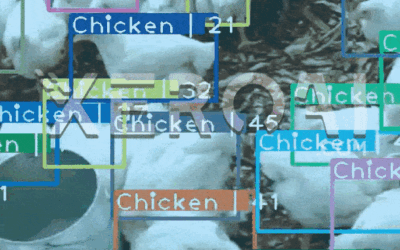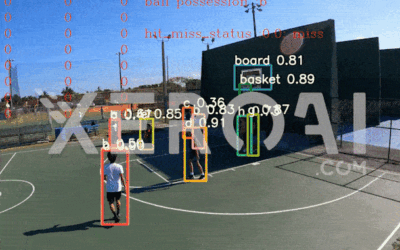In today’s fast-paced world of sports, harnessing the power of technology has become a game-changer, especially when it comes to tennis. The age-old sport of tennis has embraced cutting-edge technologies like artificial intelligence (AI), computer vision, and deep learning to take player and match analysis to new heights. In this blog, we’ll dive into how these advanced technologies are transforming the way we analyze tennis players and matches, providing valuable insights for players, coaches, and fans alike.
1. The Benefits of Tennis Analysis Using Cameras
Using cameras as a primary tool for tennis analysis offers several key advantages over traditional methods. Unlike sensors that need to be attached to players or equipment, cameras provide a non-invasive and cost-effective solution. Let’s explore some of the benefits:
1.1. Player Performance Metrics:
Cameras can capture detailed player performance metrics, including serve speed, ball placement, and movement patterns. These insights help players identify strengths and weaknesses in their game.
1.2. Match Strategy:
Coaches can analyze match footage to develop effective strategies for upcoming opponents. They can study player tendencies, preferred shots, and court positioning.
1.3. Real-Time Feedback:
During practice sessions, real-time feedback from cameras allows players to make immediate adjustments to their technique and strategy. This enhances the learning process.
1.4. Injury Prevention:
By analyzing player movements, coaches and trainers can identify potential injury risks and implement preventive measures.
2. Use Cases and Analysis Aspects in Tennis
Tennis analysis using computer vision and deep learning encompasses various use cases and aspects:
2.1. Match Analysis
Here is few match analysis using cameras and deep learning insights into player performance and strategy through advanced computer vision techniques.
2.1.1 Serve Analysis:
Cameras can track the speed, spin, and placement of a player’s serve. This information helps players refine their serving techniques. It mainly includes:
- Serve speed
- Serve accuracy
- Type of serve (e.g., flat, slice, kick)
- Ace count
- Double faults
2.1.2. Shot Selection:
Analysis of shot selection, including forehands, backhands, volleys, and smashes, helps players understand which shots are most effective in different situations. Following keys metrics can be tracked:
- Forehand accuracy
- Backhand accuracy
- Volley success rate
- Smash success rate
- Drop shot success rate
2.1.3. Movement Patterns:
- Cameras can map a player’s movement patterns on the court, helping them optimize their positioning during rallies.
- Following points can be measured with movement analysis:
- Player’s court coverage
- Distance covered during a match
- Movement efficiency
2.1.4. Rally Analysis:
By tracking the length and intensity of rallies, players can assess their endurance and improve their shot consistency. This analysis can provide:
- Length of rallies
- Number of groundstroke winners
- Number of unforced errors
- Average rally duration
2.1.5. Opponent Analysis:
Analysis with cameras and deep learning enhances player performance by providing real-time insights into opponents’ strategies and weaknesses.
- Study of the opponent’s playing style
- Analysis of their strengths and weaknesses
- Preferred shots and court positioning
2.1.6. Fitness and Endurance:
Revolutionizing tennis analysis with cameras and deep learning enhances fitness and endurance insights for players through advanced performance tracking.
- Player’s heart rate and stamina during the match
- Tracking fatigue levels
- Distance covered in each set
2.2. Action Tracking
The action tracking in tennis analysis with cameras and deep learning enables precise player movement analysis for enhanced performance insights:
2.2.1. Point Analysis:
- Number of points won
- Number of points lost
- Points won on serve
- Points won on return
2.2.2. Ace Count:
- Number of aces served by the player
2.2.3. Double Faults:
- Number of double faults
2.2.4. Net Approaches:
- Number of times the player approaches the net
- Success rate at the net
2.2.5. Break Points:
- Number of break points faced
- Number of break points converted
2.3. Serve and Return
Serve speed and placement are enhanced through the revolutionary fusion of cameras and deep learning in tennis analysis.
2.3.1. Serve Speed and Placement:
- Maximum serve speed
- Serve placement (wide, T, body)
- Serve speed variations (1st and 2nd serves)
2.3.2. Return Accuracy:
- Accuracy of returns
- Returns in play
- Return winners
2.3.3. Net Play:
- Net points won
- Volley success rate
- Smash success rate
2.4. Fitness and Health
The tennis analysis with cameras and deep learning enhances fitness and health insights, empowering players to optimize their performance.
2.4.1. Heart Rate Monitoring:
- Player’s heart rate during the match
- Tracking fatigue levels
2.4.2. Injury Prevention:
- Analysis of player movements to identify potential injury risks
- Monitoring player’s body mechanics
2.5. Court Positioning
The tennis analysis using cameras and deep learning enhances player performance by providing precise real-time tracking and strategic insights.
2.5.1. Position on the Court:
- Tracking player’s position on the court during rallies
- Preferred court areas
3. Data Collection and Camera Placement
Data collection in tennis analysis relies on strategically placed cameras. Proper camera placement is essential to capture comprehensive footage without missing crucial details:
3.1. Court Coverage:
Cameras should cover the entire tennis court while minimizing interference from the audience.
3.2. Distance from Court:
Cameras need to strike a balance between court coverage and proximity to capture players’ actions accurately.
3.3. Angle:
A bird’s-eye view should be avoided, as it makes player identification challenging. Side or slightly elevated views are preferable.
3.4. High-Resolution Cameras:
High-resolution cameras capture fine details, such as ball trajectory and player expressions, improving tracking and analysis.
3.5. Multiple Angles:
Using multiple cameras from different angles enhances player tracking and provides a more complete picture of the game.
3.6. Camera Stability:
Stable cameras prevent image blurring and ensure consistent tracking.
3.7. Lighting Conditions:
Adequate lighting is necessary for clear and well-defined images.
3.8. Camera Calibration:
Proper calibration accounts for lens distortion and perspective, improving tracking accuracy.
4. Conclusion
The world of tennis analysis has been transformed by the fusion of cameras, computer vision, and deep learning. These technologies provide players and coaches with unprecedented insights into their performance, helping them refine their skills and strategies. By harnessing the power of cameras and smart technology, tennis analysis has entered a new era, where data-driven decisions are key to success on the court. As these technologies continue to advance, we can expect even more exciting developments in the world of tennis analysis. The future of tennis is smarter, more precise, and more data-driven than ever before.



